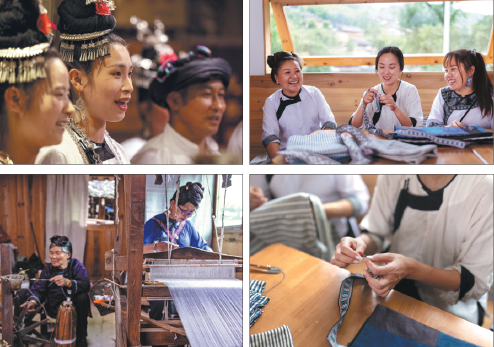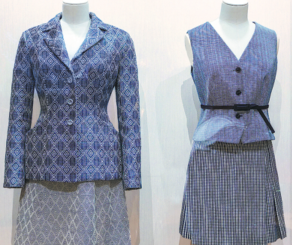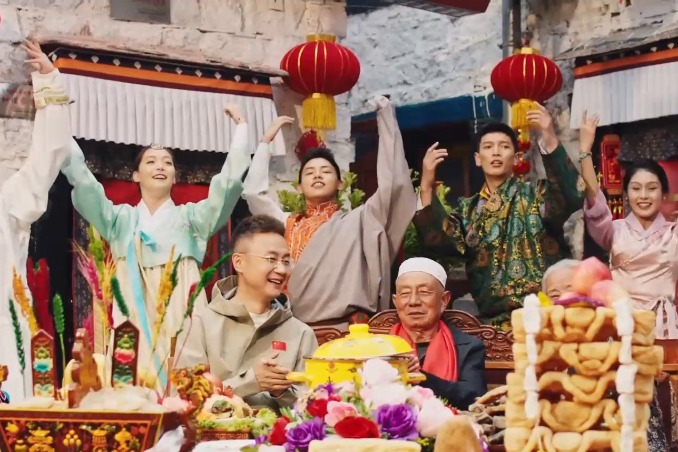A tradition worth dyeing for
The essence and luster of nature are transformed into stylish, practical garments that are deeply symbolic to the Dong ethnic group of Guizhou province, Lin Qi reports.

Ethnic costumes in China combine rich colors and patterns with style, and their distinctive beauty and grace dazzle people entering a village inhabited by the Dong ethnic group. If they do, they may be fortunate enough to see women making monochromatic dark blue fabric with a metallic sheen that they themselves wear.
It is known as liangbu (bright cloth), a special textile that takes a dozen steps to make, and which is a glittering example of handmade Dong cloth.
Located primarily in Guizhou, Hunan and Hubei provinces, and the Guangxi Zhuang autonomous region, the Dong people have developed a trove of arts and crafts over the centuries, among them Grand Song (dage), and wooden architectural structures, such as drum towers and covered wind and rain bridges.
Their traditional dress-making craftsmanship is recognized as a form of national-level intangible cultural heritage, and apparent upon entering a Dong village.
The costumes are mostly made of the Dong cloth, which is a gift of nature, dyed a dark, rich blue, using wild plants to make indigo. Both finished cloth and cotton threads are dyed. The former becomes liangbu, while the dyed threads are often woven with white threads to create a variety of patterns.
Family bond
For the Dong people, liangbu has a range of meanings. It is an embodiment of life experience, as well as of wisdom derived from nature, and it helps them cope with cool, moist weather. It continues a time-honored tradition of handicrafting. And it is also a bond connecting family members across generations.
"As a child, I often heard my mother saying that girls needed to learn to make Dong cloth, and that anyone who didn't know how was considered incapable," says Yang Shenghua, a resident of Dali Dong village in Rongjiang county, Guizhou's Qiandongnan Miao and Dong autonomous prefecture.
The 55-year-old began to learn the craft when she was about 12, under the guidance of her mother Yang Xiuying. She remembers that the process, which begins with spinning thread, was rather difficult for a young girl to learn.
"I learned to weave a meter, and another meter, until I was able to produce a piece as long as my mother could make. I also went to the mountains to pick banlangen (indigo woad root, Isatis indigotica), an essential ingredient in preparing the dye for the cloth," she says.
The finished dye is made using water from boiled cowhide, and egg whites. The cloth is wrung, scrubbed and pounded, before it is turned into traditional Dong garments — dark indigo outfits with a colorful flower trim for the women, plain for the men.
Hu Xiaomei, a researcher and curator at the Ethnic Costume Museum at the Beijing Institute of Fashion Technology, says that indigo dye has been used for centuries to make textiles. It can be found in many cultures, and its use in making Dong cloth is well-preserved and recognized.
Yang Shenghua says the process of making cloth is complicated and involves many steps, each of which is time-consuming. "It is like a construction project," she adds.
She says that her mother was strict about the making process. "She preferred to leave the cloth to dye for longer than usual to achieve a really dark blue. Then, you had to starch, pound, dye, dry and pound again. …All I can remember was repeating those steps again and again.
"Once you have made a mistake, you'll make more. This is really frustrating, as you need to start all over, and be focused and cautious to avoid making the mistake again," Yang Shenghua says.
Hu says the cloth is pounded to flatten the outer layer of cotton threads. This leaves no space between the threads, and tightens its structure.
"The Dong survived by growing rice. They needed thick, tight fabric like liangbu, to protect them from bushes as they farmed in the mountains," she says.
Yang Shenghua says she also learned to make waistbands and head covers out of the cloth, as well as how to do embroidery and lacework. "We relied on our hands for our clothes; we were self-sufficient," she adds.
In Dong villages, a mother traditionally gives liangbu as a wedding gift to her daughter, and when the daughter later gives birth, the grandmother usually gifts her a woven patterned baby carrier.
"This is only for the dearest family members," she says.
Seeds of revival
After Yang Shenghua married, she had less and less time for weaving, as she was preoccupied with housework, farm chores and raising children and grandchildren.
Then, one day, an architect changed everything.
Taiwan-born designer Jenny Chou, who has a studio in Beijing with two friends she studied with at the Rhode Island School of Design, the United States, visited Dali Dong village for the first time in the autumn of 2015 on a business trip. She happened to see villagers harvesting indigo and soaking it in vats to make dye.
Chou was fascinated by their perseverance, and that weaving was part of the Dong way of maintaining their traditional styles in an industrialized age.
"Making Dong cloth is not a task for one person alone," Chou says. "Spinning and winding thread, weaving it on the loom to produce white cloth, dipping it in the indigo dye, it takes about a year to complete a pi (a Chinese measurement of length, roughly equivalent to 33 meters)."
Inspired, she went on to found the Dousa Women's Cooperative, which allows the women of Dali Dong village to not only continue the traditional craft, but also to experiment.
"I've never felt that the traditional and the modern are opposed. What is modern today will someday become a part of tradition," Chou says.
Yang Shenghua was among those who signed up for the courses at the cooperative, which she says allowed her to once again experience the joy of making cloth.
"The craft was passed on from my grandmother to my mother, and then to me. It used to be something that I was told to do because my mother and her mother did it, and I didn't want to be useless," she says. "Now it is something I like doing, because it is part of our tradition and culture.
"I have a small stand in the village, where I sell handmade textiles to tourists, using patterns I designed myself. It's a way of popularizing our heritage so that it finds new life and is carried on."
Chou says Dong cloth can also be used by urban dwellers. It can be made into objects for daily use, like pillowcases, decorations and tissue boxes.
In 2017, she took Dong cloth from the cooperative in Dali Dong village to Beijing Design Week.
"I think that incorporating Dong cloth in fashion design is a natural development, just like Dior has used Dong jacquard fabric in its collection, introducing traditional Dong craftsmanship to more people," Chou says.
She refers to the several outfits on show at Dior's studio in Paris which, under the supervision of Dior's artistic director Maria Grazia Chiuri, have smartly integrated the Dong jacquard, of the classic beige-blue geometric patterns, with the fine silhouette of haute couture to present high quality and a modern outlook.
Such a combination of Eastern tradition and Western design is, according to Dior, to connect people with those industrious women in Dali Dong village, who together weave and dye, and create a variety of patterns that have been sourced from nature and found in the objects and animals in their day-to-day life.
For her part, Yang Shenghua is pleased with developments.
"When I see the color become even darker and more beautiful after every round of dyeing, it makes me happy," she says.
"Finishing a piece of cloth is like completing a gift — it is from nature, from our culture."





Today's Top News
- Israel's Gaza takeover plan widely condemned
- S. Korea visa waiver spurs surge in travel interest
- Top cities signal easing to support property market
- Ties bolster heritage protection
- Gaza 'takeover' will ignite another horrific chapter for the Middle East: China Daily editorial
- STAR shines for innovative companies






























